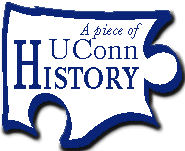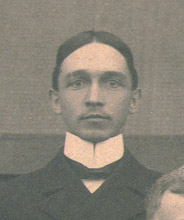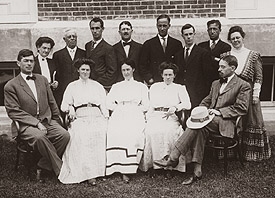|
This is an archived article.
For the latest news, go to the
Advance Homepage For more archives, go to the Advance Archive/Search Page. | ||||
|
Summer Time, But Many Students Opt
for Study, Not Easy Livin' Summer courses have been offered at the University continuously since 1937, but the history of the summer sessions goes back to 1901 and Rufus W. Stimson. And it includes close ties to a leading American geneticist, who taught what is believed to be the first organized college course on genetics.
From its first academic year in 1881-1882, the Storrs Agricultural School offered a "summer term" of what was until 1914 a trimester calendar. The fall term ran from late September up to the Christmas holiday break, the winter term from January through March and the "summer" term from April through June, ending just before Commencement, which until the early 1970s was always held in mid-June. A real summer school came after the start of the 20th century, just as Stimson was beginning his tenure as the head of what in 1899 had become Connecticut Agricultural College. With a bachelors and masters from Harvard, and after he graduated from Yale Divinity School, Stimson came to Storrs in the fall of 1897. He joined the faculty to teach English language and literature. His relatively brief term as president began after the even briefer but stormy tenure of George Flint. The Flint administration had suffered "The War of the Rebellion," so called because faculty rebelled against Flint's effort to turn the small agricultural college toward classical education. Flint, who was forced to resign, lost the battle but won the war. The little college would continue to see its curriculum expand beyond agriculture. According to Walter Stemmons, university editor from 1919 to 1954, Stimson "was young, full of energy, and ambitious for the growth of the institution. "He early undertook the building up of the summer school, which had made a feeble start in the summer of 1901 and which, under the name of 'Agriculture and Nature Study,' was to achieve considerable popularity and to provide much favorable advertising for the college among the schools of the State, from the teachers of which the summer school was largely recruited." Stemmons says the Codfish Falls in Mansfield "was a popular spot for the studying of nature. "The prospectus of the summer school, July 8 to Aug. 5, 1902, contains among other interesting items the following information: 'Bicycles may sometimes be used to advantage. Stout boots and strong skirts, trousers and jackets will be found most serviceable. Drive out to the College from Willimantic. The livery stable charge for one person is $1.50.'" Thirty-seven students were registered in the summer of 1902 for a course called "Nature and Country Life." The summer school of 1903 had 61 registered students. For several years the summer school was directed by a young faculty member who would become known as a leading figure in the genetics world in the decades before and after World War I.
Albert F. Blakeslee, born Nov. 9, 1874, received his doctorate from Harvard in 1904. He joined the faculty at Connecticut Agricultural College in 1907 to teach courses in agriculture. While at the College, he kept an experimental garden that he used for his courses, wrote a book on tree identification, and began his genetics research on plants, finally settling on Jimson weed (Datura stramonium). Blakeslee began teaching about genetics in 1913, offering what is believed to be one of the first, if not the first, organized course on genetics taught at an American college or university. In the college's annual report for 1914, Blakeslee noted that in the previous year, "a small class of advanced students were given a course in the principles of inheritance. This year Genetics has been established as a required half-year's course in the Junior Year." Also, in 1914, the summer school was suspended. The following year it was replaced by a new summer program run by the state Board of Education. The summer program started in 1915 was, according to the terminology of the time, "a normal training school" for Connecticut school teachers. That first session was attended by 396 teachers and school superintendents, but it "so overtaxed the dining hall and dormitory accommodations that attendance the following summer was limited to 183," wrote Stemmons. The summer teacher training was short-lived, however, canceled in 1918 owing to World War I, and not revived. For nearly 20 years no summer courses were offered at the college. Then, on Dec. 16, 1936, trustees approved a proposal from Albert Jorgensen, who had just completed his first year as president of what was now Connecticut State College. A flyer describing the new six-week summer program says that entering freshmen could get a jump-start on their college career by taking courses during the summer after their high school graduation, earning as much as six course credits. P. Roy Brammell was named acting director of the program for 1937. The first summer's faculty list includes a who's who of familiar campus names: Albert Waugh, later dean of liberal arts and sciences and University provost; G. Safford Torrey, University marshal and professor of biology; Andre Schenker, professor of history; and Mildred French, dean of women from 1928 to 1953, who taught home economics. Now offered through the College of Continuing Studies - trustees recently approved the change in name from Division of Extended and Continuing Education - the summer session lives on. Mark J. Roy |



